When and how to plant bulbous irises in open ground in spring and autumn: rules of care and cultivation
Named after the goddess of the rainbow Iris, these luxurious flowers bloom in all their glory in early summer, delight us with the most diverse natural variations in shades and shapes, as well as a pronounced fresh aroma. Caring for a beautiful plant is easy, so you don't have to be persuaded to buy it. However, not every gardener knows that irises can be grown from bulbs.
In order for the iris to grow and flaunt in your garden, familiarize yourself with the conditions for the correct planting of bulbous irises in open ground in spring and autumn.
By the way! About landing rhizome (bearded and beardless) irises read in a separate material.
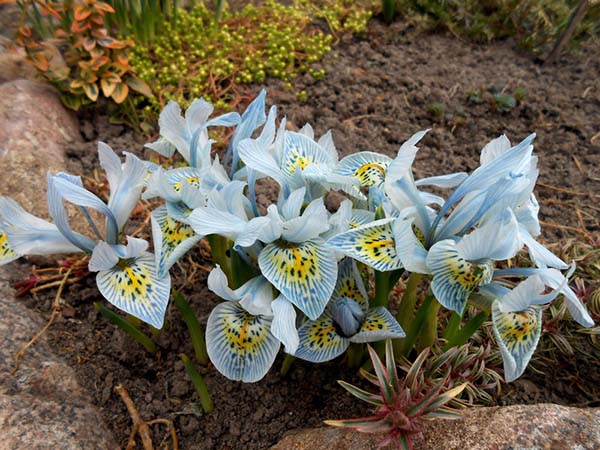
Content
Varieties and varieties of bulbous irises: descriptions and nuances of care and cultivation
As a rule, irises are self-rooted plants, they are also called rhizome (bearded and beardless irises), but there are also bulbous flowers. Despite the fact that outwardly they are very similar and it is almost impossible to distinguish them, planting and caring for them are somewhat different.
Bulbous irises include 3 distinct genera, each with its own characteristics: xyphium, iridodictium, and juno.
Xiphium
These bulbous irises got this name due to the shape of their leaves, reminiscent of swords (from the Greek "xiphium" - "sword"), respectively, they are narrow and elongated.
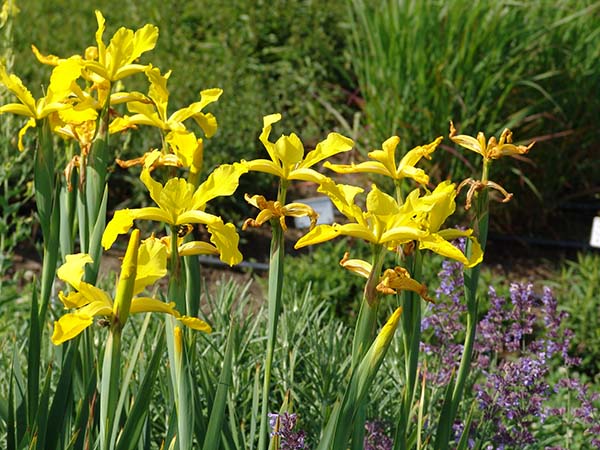
By the way! The northwest of the Mediterranean coast is considered the birthplace of xyphyums, therefore, without digging, they can only be grown in warm and dry southern regions. In the middle lane (Moscow region) it is obligatory to dig.
The shape of flowers in xyphyums is the simplest of all bulbous irises, but rather large - up to 10 centimeters in diameter. The height of the flowers themselves is from 30 to 80 centimeters.
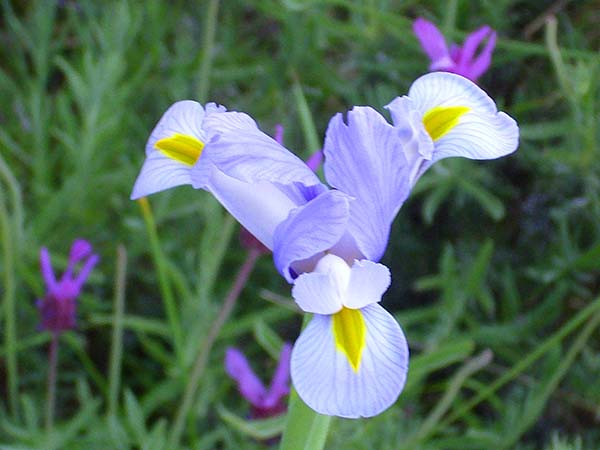
The inflorescences of these irises have purple, blue, blue, yellow or white flowers. You can often find a two-tone color. It all depends on what specific species and variety you purchase.
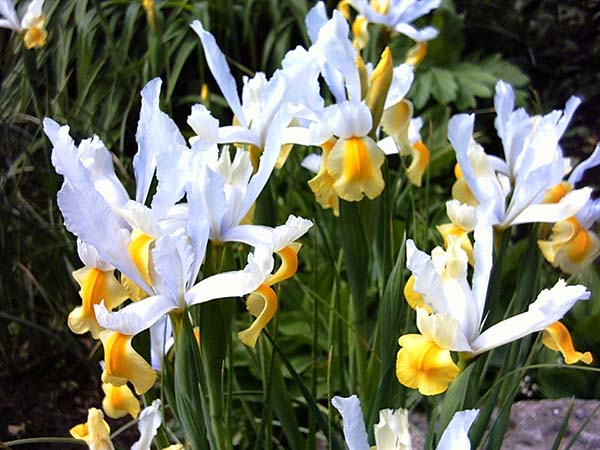
Interesting! Xyphyum is also called Dutch iris.
Iridodictium (Iridodictyum) or reticulated (reticulata)
Such a complex name ("Iridodictium") got these bulbous flowers because of the bright (variegated) color of their inflorescences (from the Greek "iris" - "rainbow") and the structure of the upper layer of the bulbs, which, as it were, in a mesh (from the Greek. "Diction" - "grid"), therefore they are sometimes called mesh.
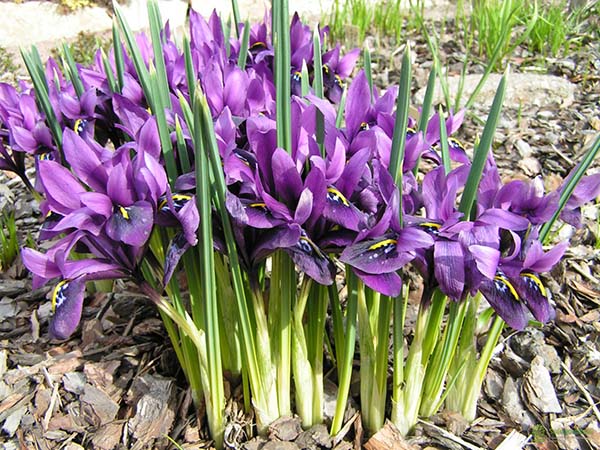
The place of active growth is the mountainous area of Central Asia and the Western Urals, as well as the Caucasus and the Balkans. Actually, therefore, they are the most adaptable to difficult conditions, for example, the same middle zone (Moscow region), and theoretically they can be grown in one place for 4-5 years without digging for the summer.
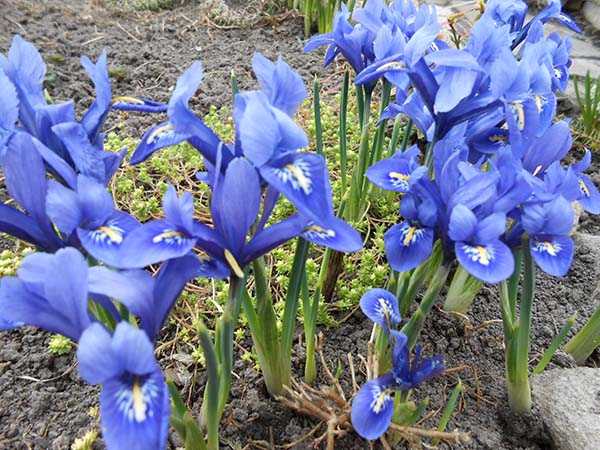
Iridodictiums are quite miniature in size. In height, they can reach no more than 15 cm, the diameter of flowers is about 5-7 cm. The leaves of these bulbous flowers are narrow and tough, appear simultaneously with the buds. A distinctive feature of iridodictiums is their amazing, one might even say, exotic flowers, which not only have a very unusual color, but they still smell pleasantly, possessing a very rich aroma.
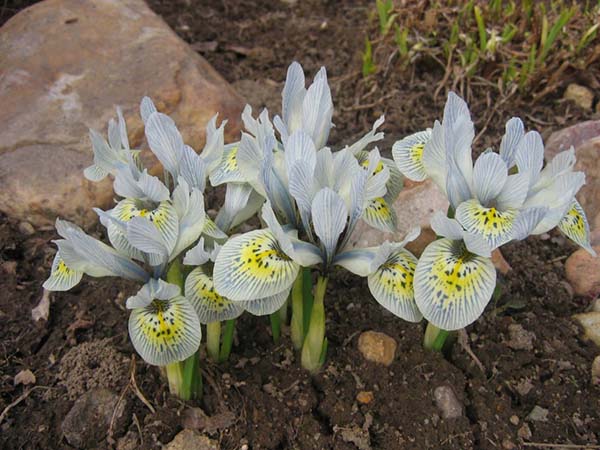
As a rule, the period of flowering of iridodictiums falls on March-April, the period is about 2 weeks.
Juno
It is not hard to guess where these bulbous irises got their name from. Yes, that's right, in honor of the name of the Roman goddess Juno, who was considered the main patroness of women.
They are very widespread in the Caucasus mountains, in Asia Minor and Central Asia, in South Africa, as well as in the Mediterranean. Therefore, along with iridodictiums, junons are considered quite viable and can grow safely up to 4-5 years in the same place without digging and transplanting.
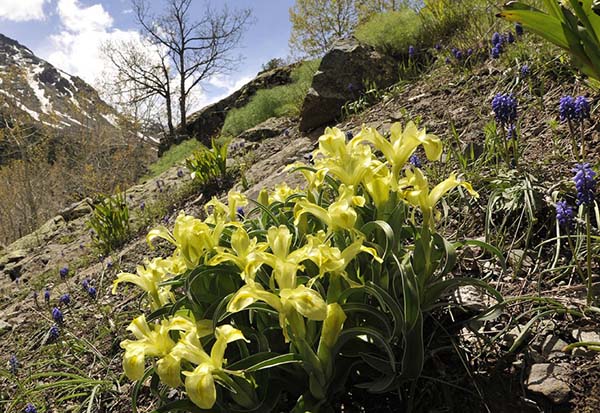
Depending on the species (they are most widely represented - 40 species, iridodictium - 11, and xyphium - only 6 species), the height of plants can vary within 10-50 centimeters.
The structure of juno is the most unusual among all bulbous irises: on the trunk, leaves grow in several rows, and from the axils of these leaves, as well as at the top of the stem, flowers appear.
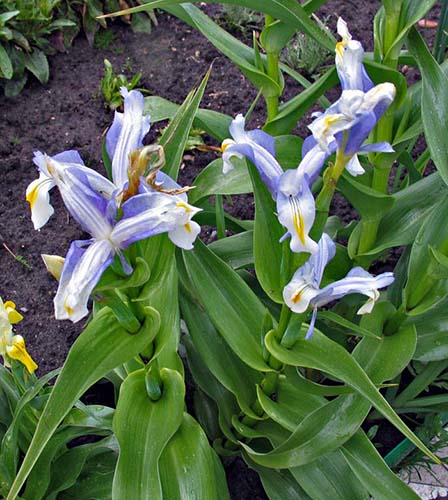
Their inflorescences, as a rule, can be white, yellow, purple and lilac in color. And some species have a very pleasant smell.
In most cases, junos bloom a little later than reticulated irises, that is, in April-May, but longer, somewhere in 2-3 weeks.
By the way! Juno is very fond of aridstony places, that is, she practically does not need any additional watering.
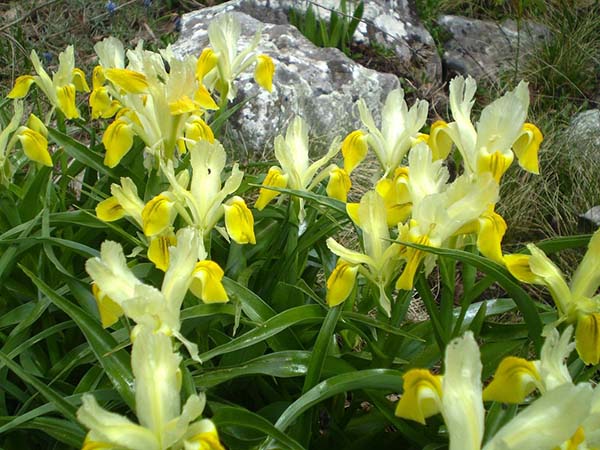
When to plant bulbous irises: optimal timing
The optimal planting time for bulbous irises is late summer - early autumn. In general, it is better to plant small-bulbous ones a little earlier, because with shallow planting, the bulbs can suffer with a sharp drop in temperature, so it is better to give them more time to root.
So, in Middle lane (Moscow region) irises are best planted late August - early September, and in warm southern regions the procedure can be rescheduled and for october, which definitely cannot be done in the Urals and Siberia.
However, it often happens that in early spring (or at the end of winter - in February) iris bulbs appear on sale, you cannot help buying them, or they are presented to you. What to do in this case?
Important! It will hardly be possible to save them until autumn, because they will either dry out, or rot, or simply grow out.
To plant bulbous irises in the spring and try to get them to bloom already this season, you can try to simulate the cooling period, namely: put them in the refrigerator in a box or in some kind of container (and so that the sprouts, if they sprout, look up, and not bent), or put it in a pot of earth and put it on the balcony or in the same refrigerator. And then land in April-May.
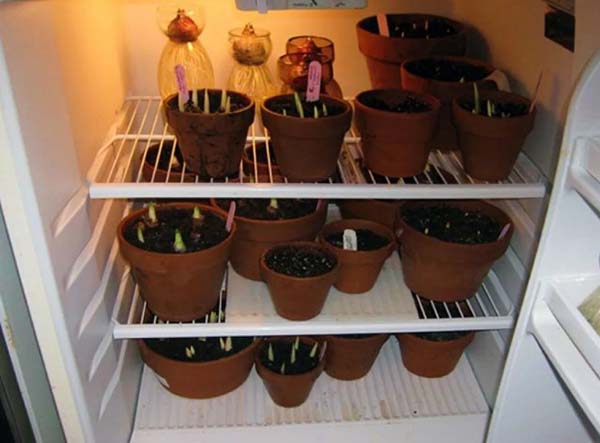
By the way! According to flower growers, irises planted in spring most often really bloom this year, but only in summer.
How to plant bulbous irises in open ground: rules and recommendations
In order to successfully grow your favorite flowers, you must consistently and clearly follow the following rules and recommendations.
Planting site and soil
It is optimal for bulbous irises to choose a well-lit, sunny and windless place, without access to drafts, in light partial shade. Like all bulbous, lowlands (in which moisture will accumulate in spring) and areas with too close groundwater are categorically unsuitable for planting. Excessive moisture is harmful to the bulbs.
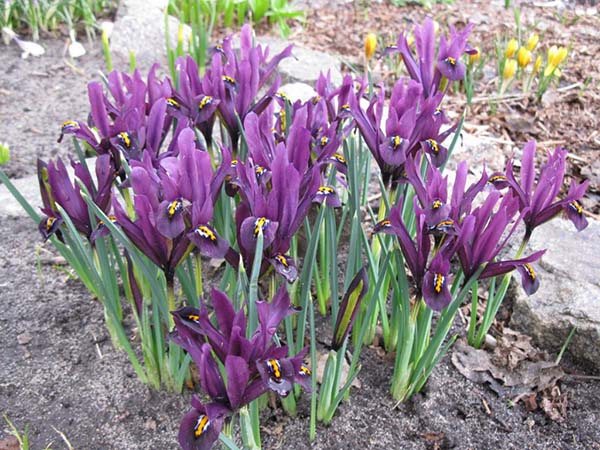
For planting spring bulbous irises, choose places near your home or near garden paths so that they often catch your eye during their short flowering. Perfect fit rock garden or rocky garden... It is beautiful to plant them next to other bulbous, blooming in early spring, for example, with the same crocuses, daffodils, tulips.
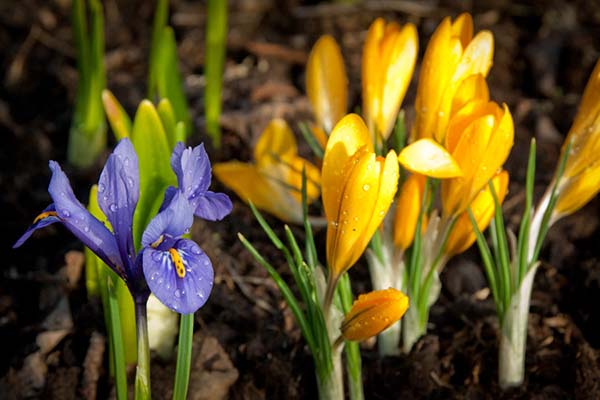
As for the soil, it is good to plant these bulbous dogs in light, permeable and fertile soil with neutral acidity.
Preparing the bulbs
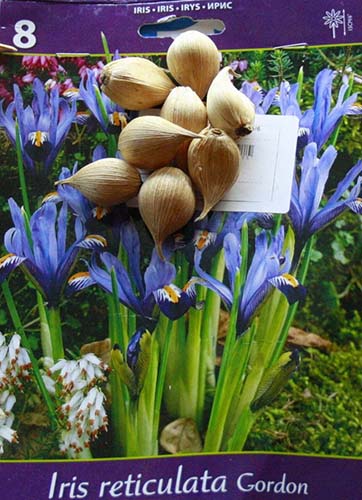
If you do not want your iris bulbs, God forbid, to rot, then before planting, hold them in a solution of potassium permanganate or a special fungicide for etching, such as "Maxim Dachnik" or "Fundazol".
Direct landing
Step-by-step instructions for planting bulbous irises in open ground:
- Decide on the best place for growing.
- Prepare planting holes and soil. Make drainage (pour a small layer of sand), if necessary (for loose soil, it is not needed).
- The planting depth of iris bulbs is 3 bulb heights, that is, about 5-8 cm.
- The distance between the iris bulbs is 2-3 bulb diameters (6-10 cm). But if you want to get a beautiful bouquet, then plant it closer.
- Place the bulbs on the bottom of the hole and press them lightly into the ground (or sand).
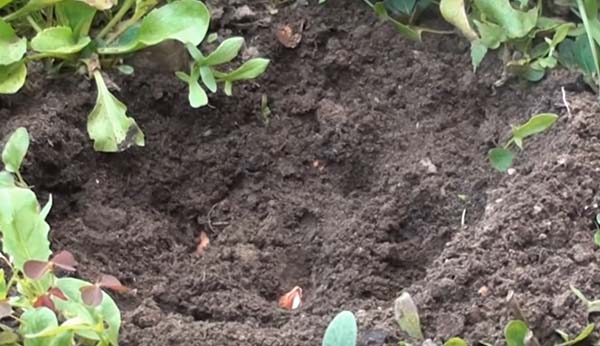
- Cover with fertile soil.
- Drizzle slightly with water.
- Cover with compost or peat.
How to care for bulbous irises outdoors
In principle, there is nothing difficult in the care and cultivation of bulbous irises, but some standard garden manipulations still have to be remembered and carried out.
Watering
Bulbous irises require moderate watering. It is especially important not to forget to water the plant in dry weather (including in the fall after planting, if there is no rain at all), namely during the period of their active growth, that is, during the formation of buds and direct flowering. At the end of flowering, watering is no longer required. Flowers need now period dry rest.
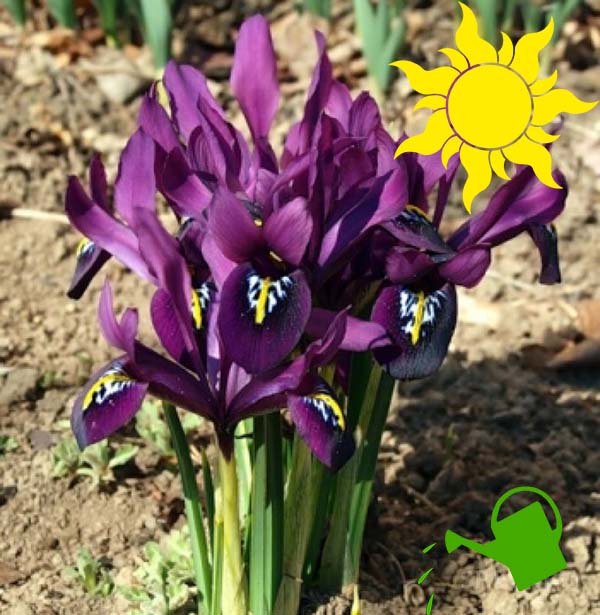
Advice! If you do not want an unaesthetic earth crust to form around the irises after watering, do not forget to loosen the soil.
Top dressing
If you want a brighter and more lush bloom, then you should fertilize the irises several times in the spring.
- So, during the first feeding, which should be performed immediately after removing the shelter, that is, in the very early spring, at the beginning of the growing season, you need to make nitrogen fertilizer (a small content of potassium and phosphorus is also allowed).
- When will the period start budding, then the flower should be fed already potassium-phosphorus fertilizer (with big contentpotassium, the presence of nitrogen is also allowed).
- Immediately after flowering should be done exclusivelyphosphorus-potassium top dressing.
Digging the bulbs
It is very important to dig up the iris bulbs on time, otherwise they can rot due to excessive moisture (rain). If tulips, as a rule, they are dug up only after their leaves turn yellow, then in the case of bulbous irises, you do not need to wait so long. It is optimal to get them out of the ground approximately 2 weeks after floweringwhen they just wilt slightly and begin to turn yellow. As a rule, this moment falls on the end of May - beginning of June.
Note! Irises do not need to be dug out for the summer if during this period you (in your climatic zone) have no rain at all, because they require a dry dormant period.
The dug iris bulbs should be disinfect in a pink solution of potassium permanganate or any other fungicide (for example, "Maxim Dachnik" or "Fundazol"), then as followsdry (2-3 weeks) and put in storage in a dry room with good ventilation until a new autumn planting in open ground.
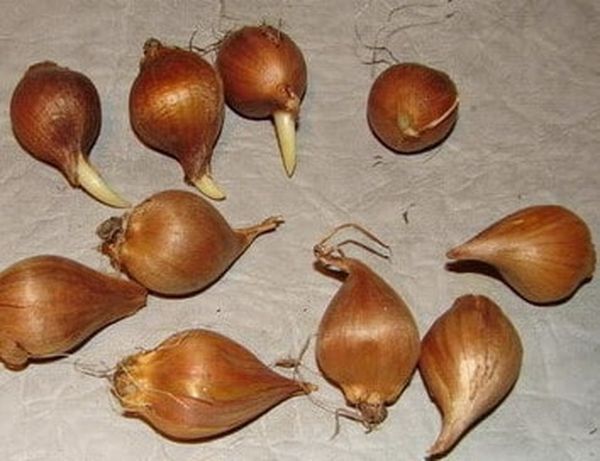
Important! As mentioned earlier, each genus of bulbous irises has its own characteristics of cultivation. So, xyphyums should be dried at a higher temperature (+ 30-35 degrees), and Iridodictiums and Juno - medium enough (+ 20-25 degrees). In the last days of drying, the temperature should be lowered to + 15-18 degrees.
Shelter for the winter
If autumn is rainy, then so that the iris bulbs do not get wet from excessive moisture, they should be covered with something, for example, roofing material or a plastic cake box.
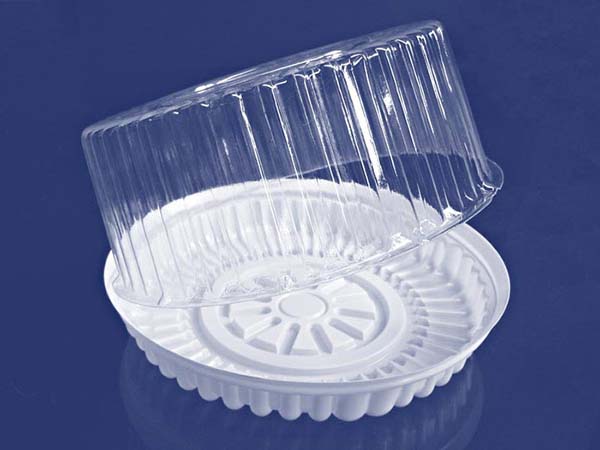
If your winters are cold and snowless, then spruce branches and dry leaves are suitable for winter shelter, you can also cover it with spunbond or film. Especially the more thermophilic junons need shelter for the winter.
Important! Do not forget to remove the shelter in early spring (immediately after the snow melts).
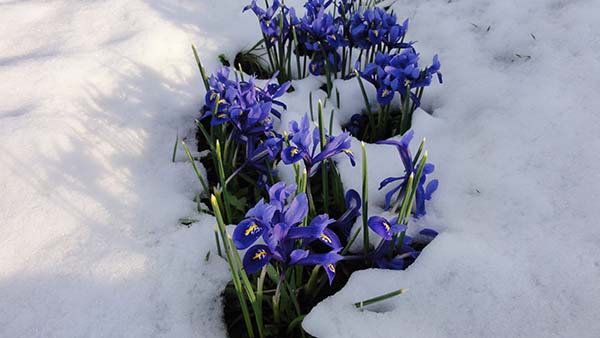
Thus, the main care for bulbous irises in the spring is to remove the shelter, water them (and then loosen them), top dressing and digging at the end of flowering.
To get more positive from a delightful flower, you need to seriously think about the intricacies of planting and growing bulbous irises in the open field.
Video: features of planting and growing bulbous irises

